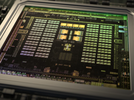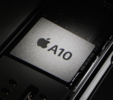Nvidia Tegra X1 vs Apple A10X Fusion vs Apple A10 Fusion
Nvidia Tegra X1
► remove from comparison
The NVIDIA Tegra X1 (Tegra 6, Codename Erista) is a 64-Bit high performance ARM based SoC (System on a Chip) for (mainly Android based) tablets and embedded systems (like cars). It contains four ARM Cortex A57 and four ARM Cortex A53 cores in the processor part. As a graphics card, Nvidia integrated a Maxwell based GPU with 256 CUDA cores (see for more details and benchmarks). The integrated memory controller supports LPDDR3 and LPDDR4 with a maximum bandwidth of 25.6 GB/s (2x 32 Bit LPDDR4-3200). The Tegra X1 is the successor to the exactly one year earlier announced Tegra K1 SoC.
Similar to the Symsung Exynos 5433, the Tegra X1 uses a big.LITTLE combination of four power saving and small Cortex-A53 cores and four powerful Cortex-A57 cores. Nvidia however uses an own cluster migration solution instead of the ARM Global Task Scheduling (GTS) and therefore only one of the two quad-core clusters is active at a time.
The performance of the processor cores should be in the high-end segment of ARM based SoCs. Nvidia states that the X1 offers a twice as high energy efficiency compared to the Exynos 5433 (same ARM cores at 1.9 GHz manufactured in 20nm).
Due to the big Maxwell graphics card the SoC is mainly aimed at tablets with good cooling solutions and wont be commonly seen in smartphones. The Tegra X1 is produced at TSMC in 20nm.
Apple A10X Fusion
► remove from comparisonThe Apple A10X Fusion is a system on a chip (SoC) from Apple that is built into the 2017 iPad Pro models. It integrates six 64 Bit cores that are divided in two clusters. Three high performance cores are clocked at up to 2.39 GHz. The three power saving cores are used for non demanding tasks. It looks like only one of both clusters is able to run at a time (therefore the apps see only three cores). The principle is similar to the first generation of ARMs big.LITTLE concept.
The performance of the SoC is positioned in the high and and clearly faster than all previous Apple SoCs. Even compared to Android high-end SoCs like the Snapdragon 835, the A10X takes the lead (e.g. in Geekbench or Antutu).
The integrated graphics card of the SoC will most likely stem from PowerVR (again) and features 12 cores instead of 6 in the A10 SoC.
According to TechInsights, the A10X is manufactured in the brand new 10 nm FinFet process at TSMC. Altough it offers more function blocks, the A10X is with measured 96.4 mm2 significantly smaller than the previous A9X (143.9 mm2).
Apple A10 Fusion
► remove from comparison
The Apple A10 Fusion is a system on a chip (SoC) from Apple that is built into the iPhone 7 and iPhone 7 Plus. It integrates four 64 Bit cores that are divided in two clusters. Two high performance cores are clocked at up to 2.34 GHz and should be around 40% faster than the Apple A9 (according to Apple) and two low power cores (up to 1.1 GHz?). Up to now its unclear if all four cores can be used at once (that need only 1/5 th of the energy in some use cases). At the release of the iPhone 7 it looks like that IOS is only using two cores at a time and automatically switches between the two clusters. Therefore, apps are seeing only a dual core. The principle is similar to the first generation of ARMs big.LITTLE concept.
The integrated graphics card of the SoC will most likely stem from PowerVR (again) and perform 50% faster at 2/3 of the power consumption (according to Apple).
All in all the chip includes 3.3 billion transistors, which is more than a current AMD Bristol Ridge (3.1) and Skylake Quad-Core (1.75) X86 SoCs.
Sources: Apple Keynote, Ars Technica
| Model | Nvidia Tegra X1 | Apple A10X Fusion | Apple A10 Fusion |
| Codename | Erista (Cortex-A57 + A53) | Cyclone 4? | APL1021 Hurricane / Zephyr |
| Series | NVIDIA Tegra | Apple Apple A-Series | Apple Apple A-Series |
| Clock | 2000 MHz | 2390 MHz | 2340 MHz |
| L1 Cache | 576 KB | ||
| L2 Cache | 2.5 MB | ||
| Cores / Threads | 8 / 8 | 6 / 3 | 4 / 2 |
| Technology | 20 nm | 10 nm | 16 nm |
| Features | 4x Cortex-A57 + 4x Cortex-A53, 2x 32 Bit LPDDR4-1600 (25.6 GB/s, max. 4 GB), Maxwell-GPU (256 Shader, OpenGL ES 3.1, OpenGL 4.5, DirectX 11.2, CUDA 6.0), Dual ISP (1.3 GP/s), H.264/H.265 4K60 Encoding/Decoding, HDMI 2.0, eMMC 5.1 | ARMv8 Instruction Set | ARMv8 Instruction Set |
| iGPU | NVIDIA Tegra X1 Maxwell GPU ( - 1000 MHz) | Apple A10X Fusion GPU / PowerVR | Apple A10 Fusion GPU / PowerVR (900 MHz) |
| Architecture | ARM | ARM | ARM |
| Announced | |||
| Transistors | 3300 Million | 3300 Million |
Benchmarks
Average Benchmarks Nvidia Tegra X1 → 100% n=7
Average Benchmarks Apple A10X Fusion → 242% n=7
Average Benchmarks Apple A10 Fusion → 194% n=7
* Smaller numbers mean a higher performance
1 This benchmark is not used for the average calculation




